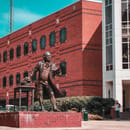1. Margaret Hamilton (1936 – present)
Calling all female engineers! In this picture, Margaret Hamilton is standing next to her handwritten code that took Apollo 11 to the moon. At the time, she was the Software Engineering director for the MIT Instrumentation Laboratory, however, she later went on to found two software companies and publish more than 130 papers. In 2016, President Barack Obama awarded her the Presidential Medal of Freedom for her work in developing the software for the Apollo Moon missions.
2. Zora Neale Hurston (1891 – 1960)
You might recognize this name from your high school English class. While she is most known for her novel, Their Eyes Were Watching God, Zora Neale Hurston made an impact as an anthropologist as well. She was the first African American to conduct anthropological research on African American folklore and voodoo. A student of Franz Boas, the father of American anthropology, she wrote her ethnographies by traveling to Caribbean areas and around the American south. Hurston was ultimately a pioneer in both African diasporic studies and feminist literature during the Harlem Renaissance.
Related: The Stories of 3 Women That Science Forgot
3. Jane Goodall (1934 – present)
Okay, so Jane Goodall is a little more well-known than the rest of our female scientists, but I still think her work is underappreciated. A primatologist, anthropologist, and conservationist, Goodall traveled to Tanzania in 1960 to study chimpanzees- a species in which there was previously little information about. Her research mainly focused on the social relationships in groups of chimpanzees. However, she took an unorthodox approach to study this: immersion. Goodall’s biggest achievement to come out of this research was seeing that chimpanzees form social bonds and have their own personalities. Even more interesting and important, she found that chimpanzees make their own tools. Her findings changed the field as humans had been distinguishing themselves as drastically different from other primates, but it turns out we’re not as different as we thought!
4. Mary Anning (1799 – 1847)
Mary Anning’s success is found in the field of paleontology, or fossils! She is known primarily for the important discoveries she made in Jurassic marine fossil beds. These findings changed the way we thought (and continue to think) about prehistoric life. Though her recovery of these fossils is monumental in the field, that doesn’t mean she saw praise for it immediately. As a woman in England, she was never able to fully participate in the Angelican, male-dominated science community. Today, the fossils recovered by Anning are recognized as a key piece in the unfolding of Earth’s history.
Related: Bias Still an Issue for Women in Science, Study Finds
5. Lise Meitner (1878 – 1968)
We all know about the atomic bombs of World War II, but who knew that a woman was behind the scenes of this technology? Lise Meitner was the leader of a group of scientists who discovered nuclear fission which helped create nuclear reactors, leading to the nuclear weaponry we have today. Though she was a leader of the team, her male counterpart, Otto Hahn, was the only one to receive the Nobel Prize in Chemistry for nuclear fission.
6. Margaret Mead (1901 – 1978)
Another anthropologist (I know- I’m an anthropology major, of course, I have to plug my field), Margaret Mead was also a student of Franz Boas like Zora Neale Hurston, but her work revolved around cultural relativism. Simply put, this is the idea that what might be unacceptable in one society could be praised in another. These factors are determined by the culture’s standards, not biology. Her most famous work, Coming of Age in Samoa, is a detailed account of her research on sexuality among Samoan girls and boys which implied that nurture has more of an effect on an individual than nature. So, why is this important? Because before Boas and Mead, anthropology had a particularly ethnocentric view of the world, but her ideas about cultural relativism became an influential point in the field, changing the way anthropologists think about and study other cultures.
Related: 5 Important Women in Science That We All Should Know About
7. Alice Ball (1892 – 1916)
Similar to Rosalind Franklin’s case, a male scientist took Ball’s work and made it his own. Alice Ball was a chemist who developed a viable technique to cure leprosy. Due to an untimely death, she was unable to publish her research and technique, which led to chemist Arthur L. Dean adding to her original work and publishing it as his own… with no mention of Ball. However, in the 1970s Ball was finally able to get the credit she deserved after professors at the University of Hawaii searched through archives and found Ball’s research.
All seven of the female scientists you just met made their own significant mark on the history of science. Will you be next, collegiette?


